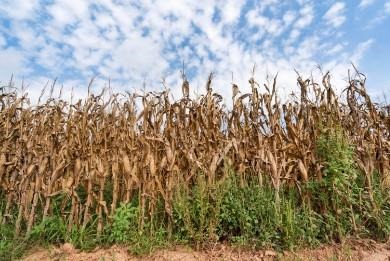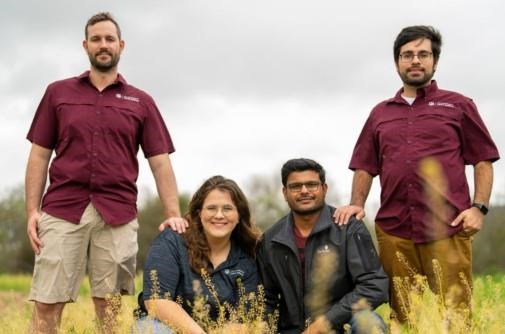By Maggie Berger
An often overlooked yet inherent part of the agricultural ecosystem, weeds can impact day-to-day life in ways one might not expect.

If not properly managed, weeds in production agriculture fields can reduce yields and causes losses in the billions.
Weeds pose a significant problem to food and fiber systems by decreasing the quality and quantity of crop yields around the world. According to the Weed Science Society of America, the potential loss in value for corn and soybeans crops if not properly treated for weeds is $43 billion annually. Without weed control, estimates show that weeds could lower corn yields by 52% and soybeans by 49.5%.
As weeds develop resistance to herbicides, to meet the needs of the growing population, the world needs alternative approaches to conventional weed management practices.
Discovery and innovation within weed science
Weed science can be summed up as the study of plants that are out of place. More specifically, this branch of crop sciences seeks to understand how unwanted plants behave and to find effective ways of controlling them. The field of weed science applies to agronomic crops, but also to turfgrass, horticulture, pasture, forests, plant nurseries, right of ways, industrial areas and water bodies.
“Primarily, we consider any unwanted plant that grows in agricultural fields or other managed ecosystems that competes with the desirable plant for resources such as nutrients, water, sunlight and space a weed,” said Muthukumar Bagavathiannan, Ph.D., associate professor of weed science and agronomy in the Department of Soil and Crop Sciences at Texas A&M College of Agriculture and Life Sciences. Bagavathiannan leads a rigorous research group that is gaining national and international recognition in weed science research.
Bagavathiannan’s efforts in weed science focus on weed ecology and management. His goal is to understand the evolutionary biology and dynamics of herbicide resistance in weed communities and develop precision integrated weed management solutions for effectively tackling weed issues, especially by targeting weed seedbanks. Notably, his program utilizes digital technologies in precision weed detection and recognition, management and ecology.
Complementing his research efforts, he helps train and empower the next generation of weed scientists.
Finding a place researching the unwanted
Passion for weed science and agronomy and the desire to improve production agricultural practices unite Bagavathiannan, his fellow faculty members and their students. But the weed science program is the reason many students choose to further their education at Texas A&M University.
“We are all passionate about weed science and want to make an impact in this field,” said Sarah Chu, weed science doctoral student. “Under Dr. Bagavathiannan’s direction, we are doing exactly that.”
The interdisciplinary approach to weed science research taken by Bagavathiannan presents students with opportunities they would not find elsewhere, while his leadership encourages students to be curious and think outside the box. His approach to research and the reputation of the program are unique, attracting the best and brightest students from across the globe.

Graduate students Andrew Osburn, Sarah Chu, Bholuram Gurjar and Gustavo Camargo Silva hope to make a difference for farmers and producers through their research in weed science.
Several of Bagavathiannan’s graduate students competed at the 2023 Weed Science Society of America Meeting in Arlington, Virginia, recently. Chu and fellow graduate students Bholuram Gurjar, Sarah Kezar, Andrew Osburn and Gustavo Silva came home with awards and recognitions. They all say weed science has become a passion they will carry for many years to come.
“I just knew I liked to work with plants and be out in the field,” Silva said. “I quickly found out I enjoyed learning about how weeds behave and overcome the standard weed control strategies. I knew there was always something new to learn about weeds and they are always a challenge, so I decided to get my master’s at Texas A&M and stay for my doctorate in weed science with Dr. Bagavathiannan.”
Gurjar said his passion for sustainable agriculture and the environment, and desire to find solutions to the negative impacts of herbicides and chemical weed control prompted his interest in weed science.
“I come from a farming family where I grew up watching my father work hard to grow crops,” he said. “That inspired me to make a difference in the farming community by improving crop productivity and making the lives of farmers easier.”
Osburn and Chu have similar stories.
Students outline their research focus
Chu is working toward her doctorate on harvest weed seed control methods. To protect the seedbank from incursions by weed seeds, she is creating a way to damage weed seeds that enter the combine during crop harvest. She is studying this method in cotton, wheat, rice and soybeans. She is also helping develop a newer form of control that implements blue light and a form of heat to kill weed seeds.
Gurjar is also working on harvest weed seed control, but in a different way. His research goal is to develop a pipeline for automatic weed detection in rice and turf and site-specific herbicide application using drones and ground robots. The objective is to reduce the weed seedbank replenishment using precision technologies, resulting in lower weed densities and higher crop yields the following year. Additionally, his research aim is to drastically reduce herbicide volumes compared to broadcast applications without compromising weed-control efficacy.
Osburn’s research focuses on one weed: annual bluegrass. He specifically focuses on addressing the herbicide-resistance epidemic in annual bluegrass in managed turfgrass systems.
Kezar’s research focuses on a specific weed that is highly adaptable, becoming resistant to more and more herbicides and can easily rob farmers of their cotton yields. Kezar is determined to help farmers by making sure fewer Palmer amaranth plants live to produce seeds.
In the meantime, Silva is focusing on improving how weed systems are managed. Weed system management implements several types of weed control strategies to reduce the chance of weeds adapting to one single method, like what is happening with herbicide resistance around the globe.
Not all weeds are bad
One behavior inherent to weeds is that they can quickly populate disturbed land. By doing this, they prepare the ground for more permanent plants like shrubs and trees, ensuring that a mature ecosystem can eventually grow there, said Silva. While this is problematic for farmers, it does not mean that every weed is bad. Some species have beneficial and even desirable properties.
Certain weeds are edible and used for medicinal purposes. For example, dandelion leaves and roots are used in salads, teas and herbal supplements to support liver function and digestion. And while clover may frustrate landscapers and homeowners, the plant is not entirely bad. Silva said it is one species of weed that can improve soil quality by adding organic matter, improving the soil structure and increasing nutrient availability.
Additionally, some weed species such as milkweed provide essential habitats and food for pollinators like native bees and monarch butterflies, which are critical to crop pollination and ecosystem health.
So, while people might assume every weed they see is problematic, it is important to remember that in some settings, weeds are good. Learning how to properly control weeds when they appear in the wrong setting is where Bagavathiannan and his students come in.
By exploring the interconnectedness weeds have with agricultural systems and better understanding their interactions with crops through cutting edge research, Texas A&M can help farmers safely, responsibly and economically continue to feed the world.
Source : tamu.edu